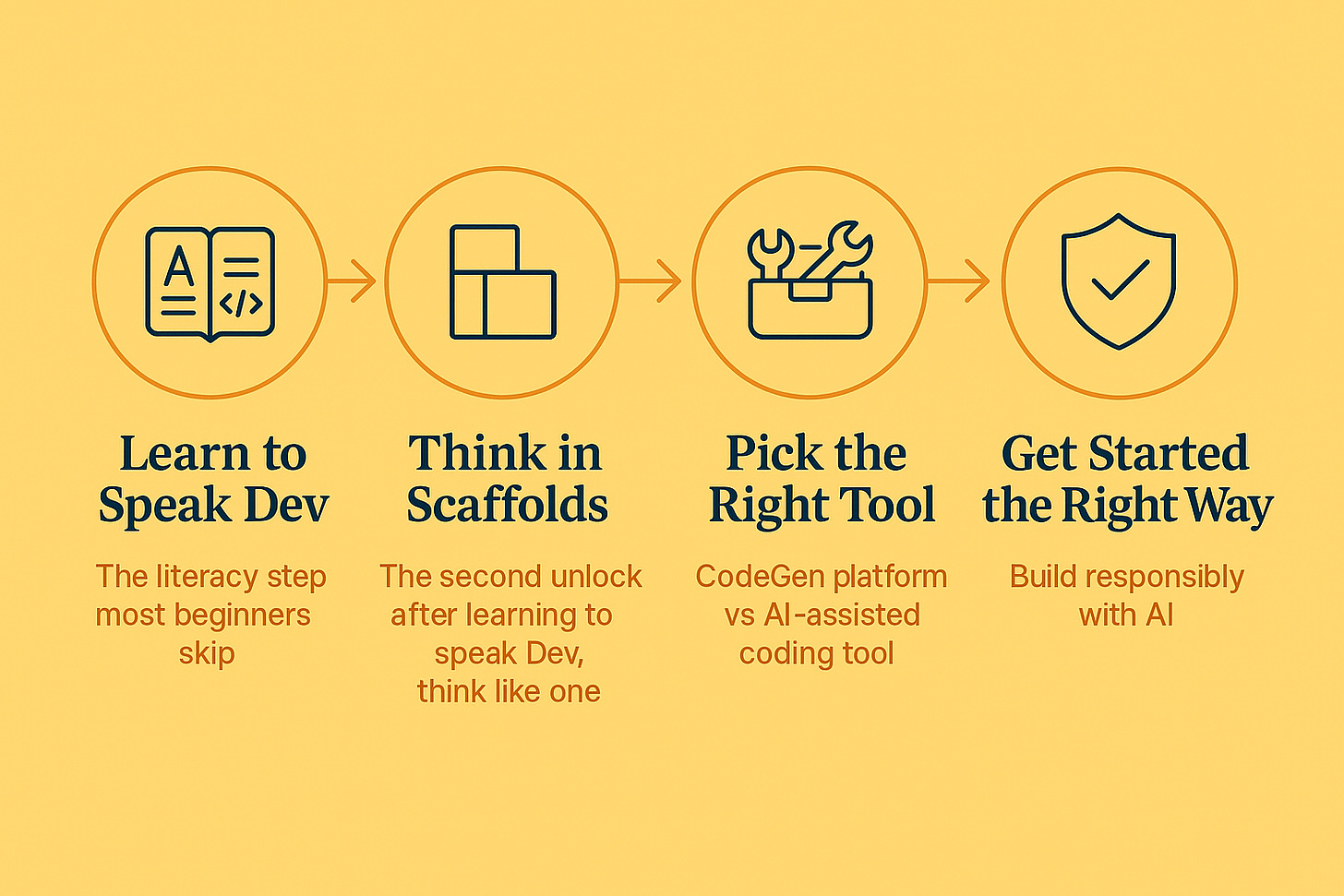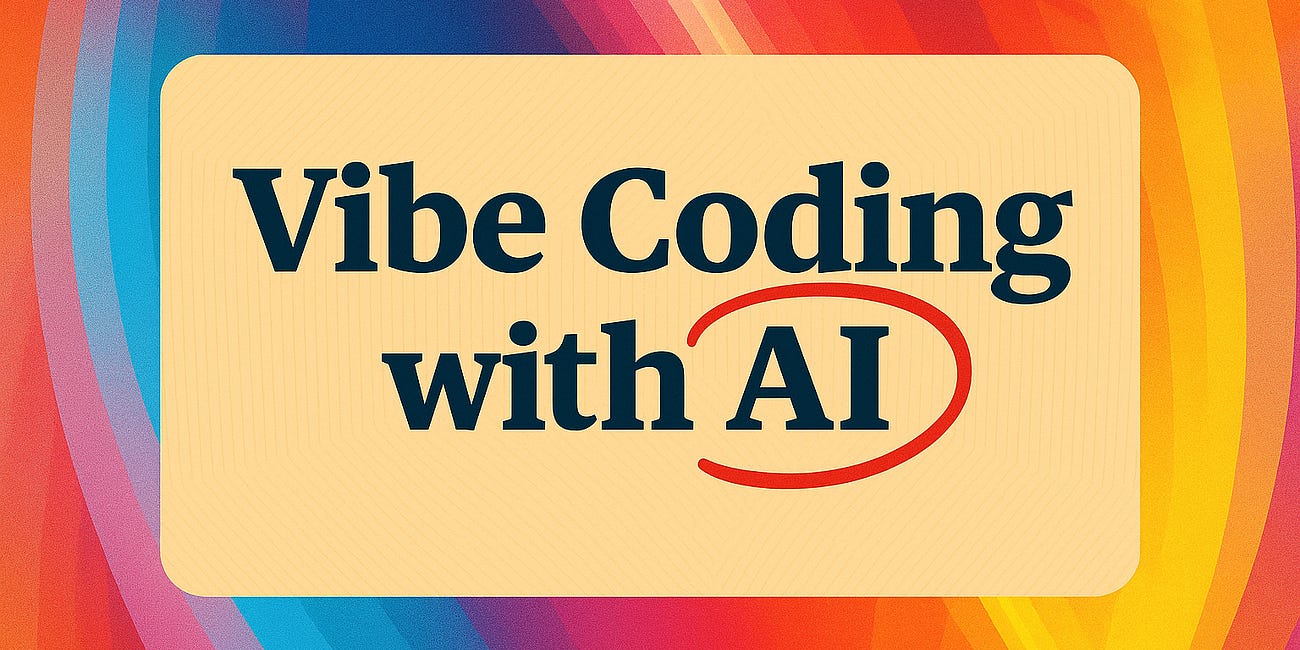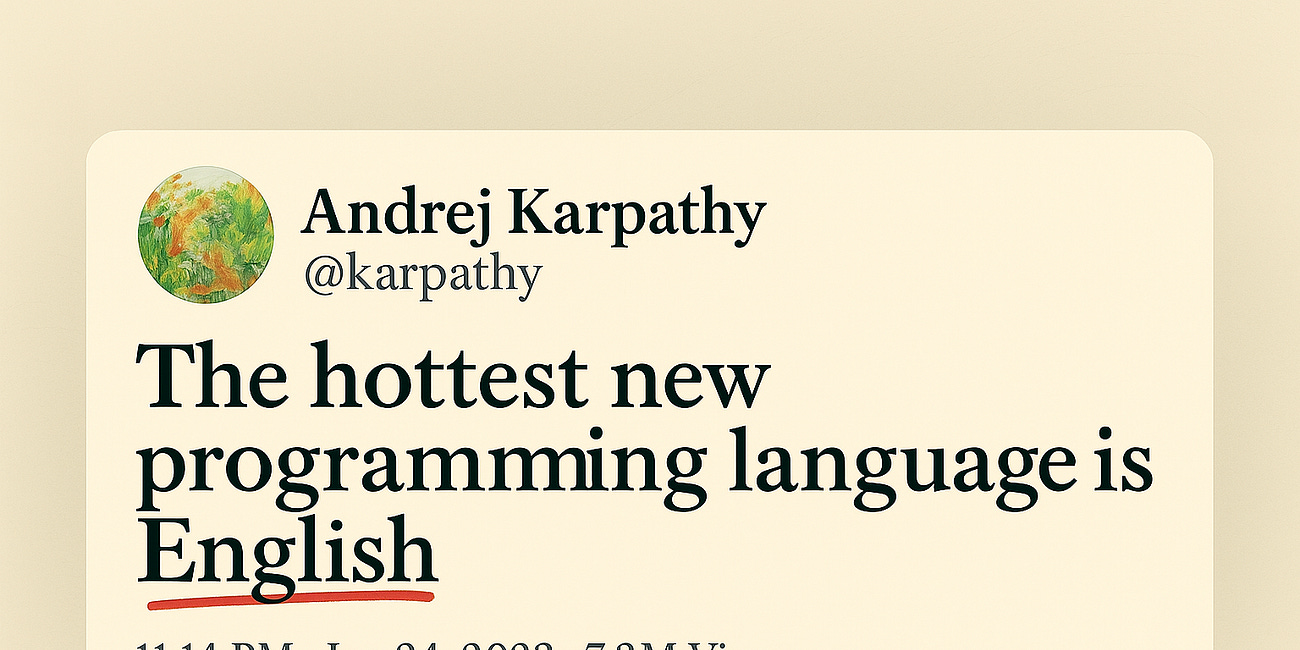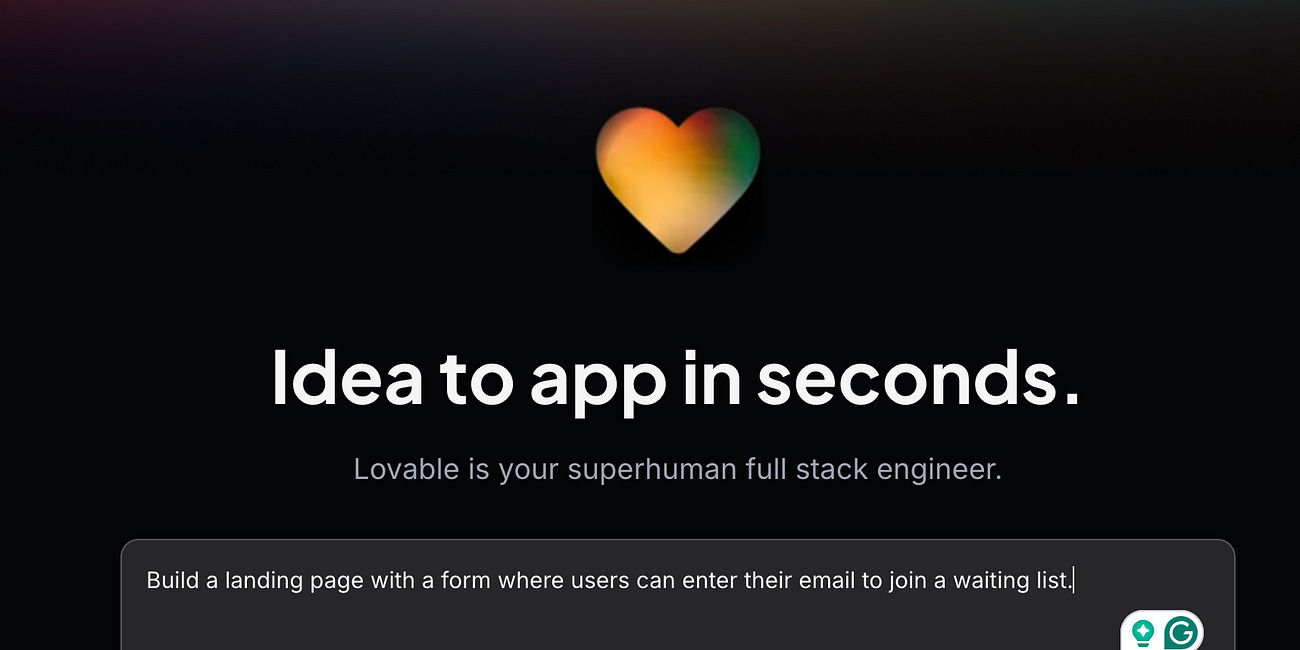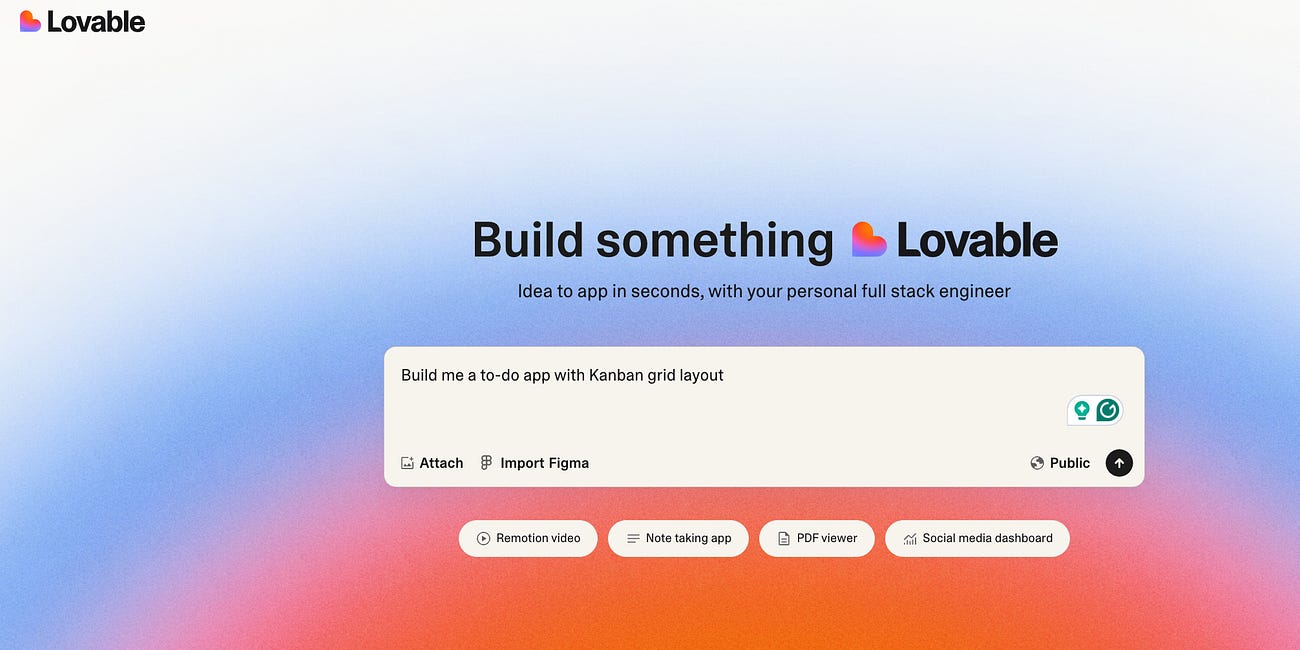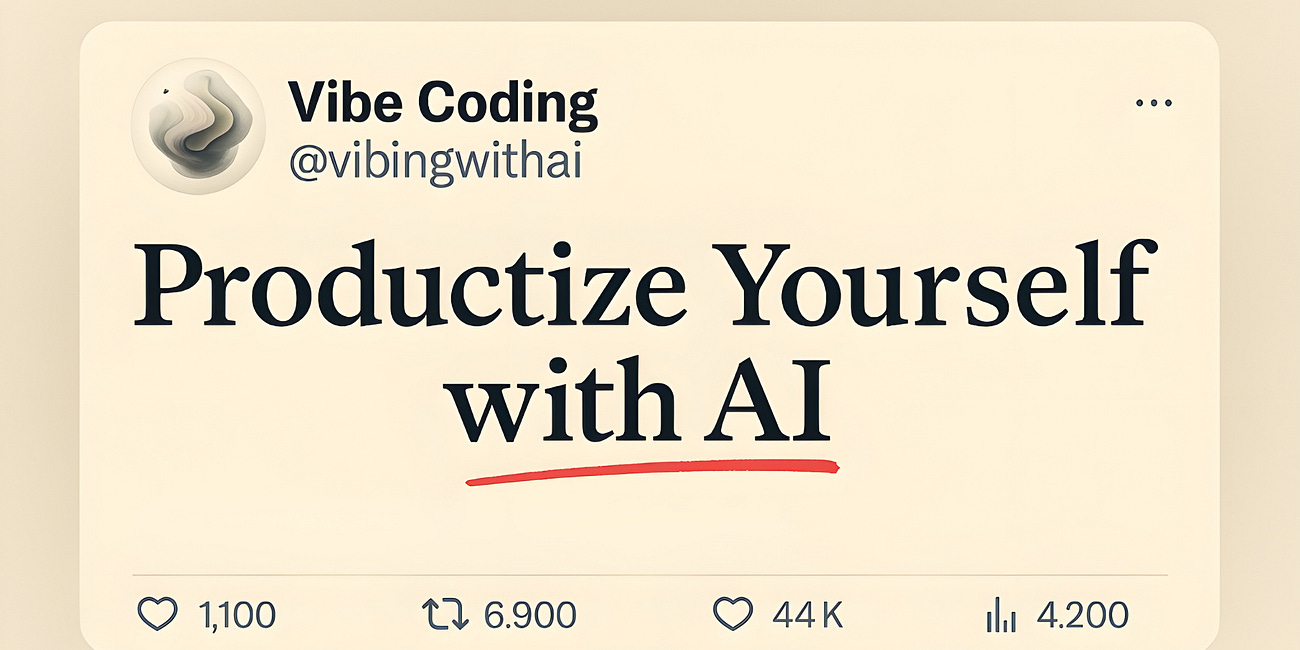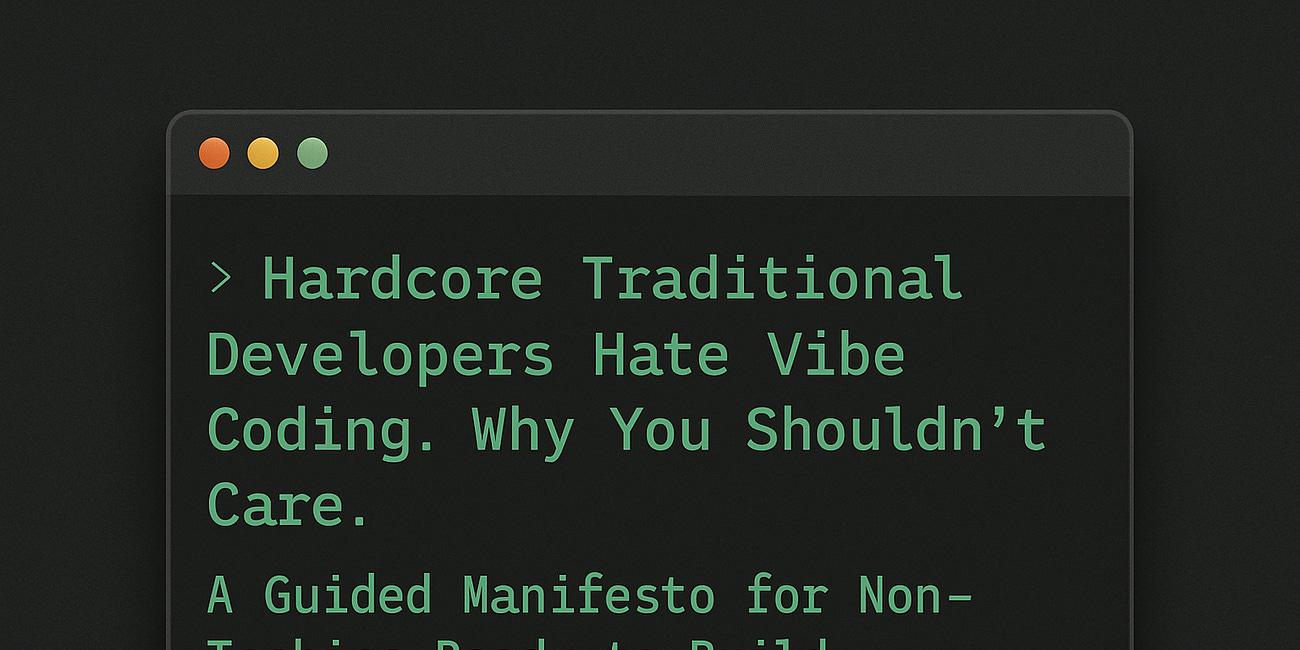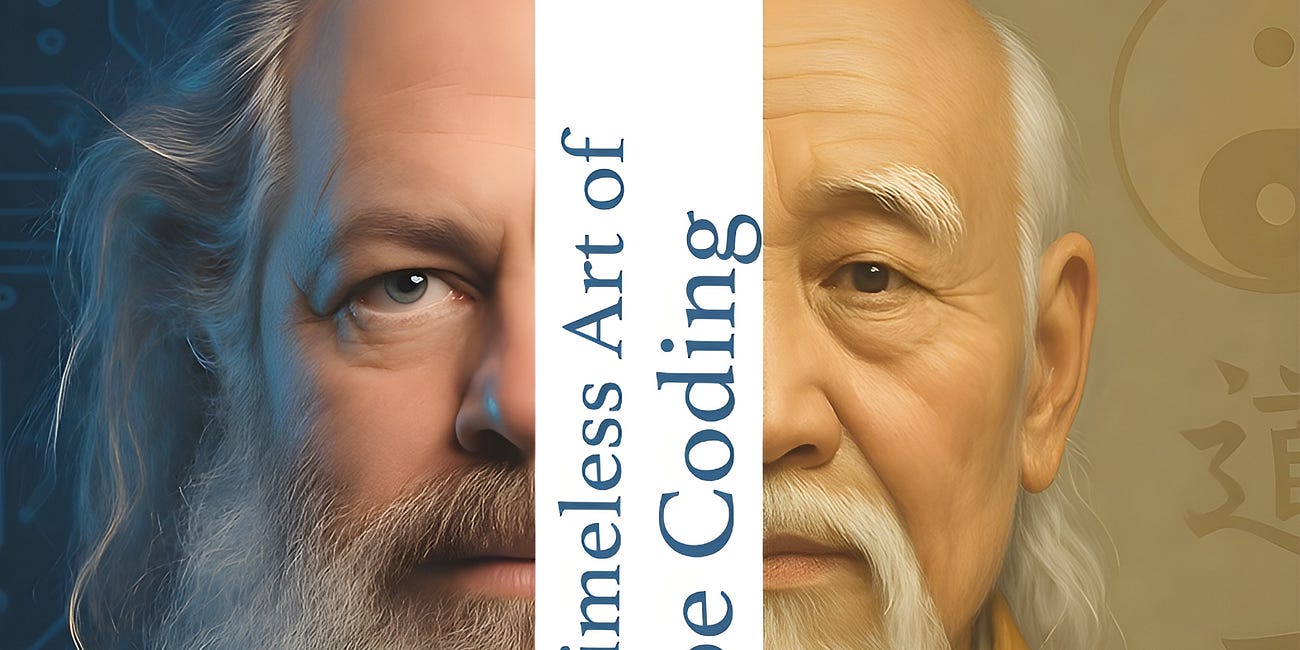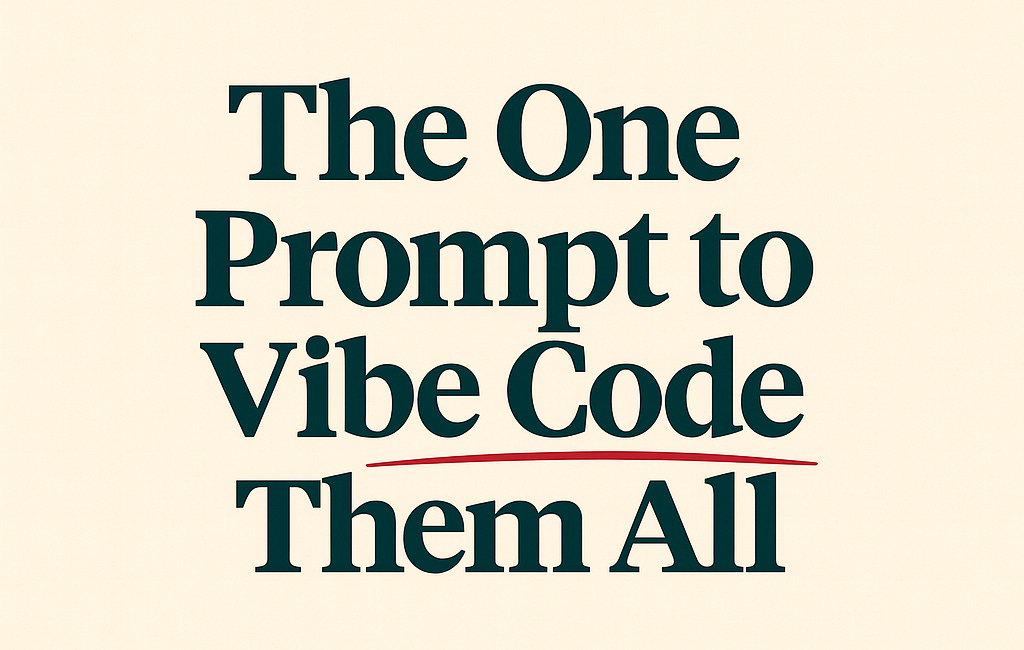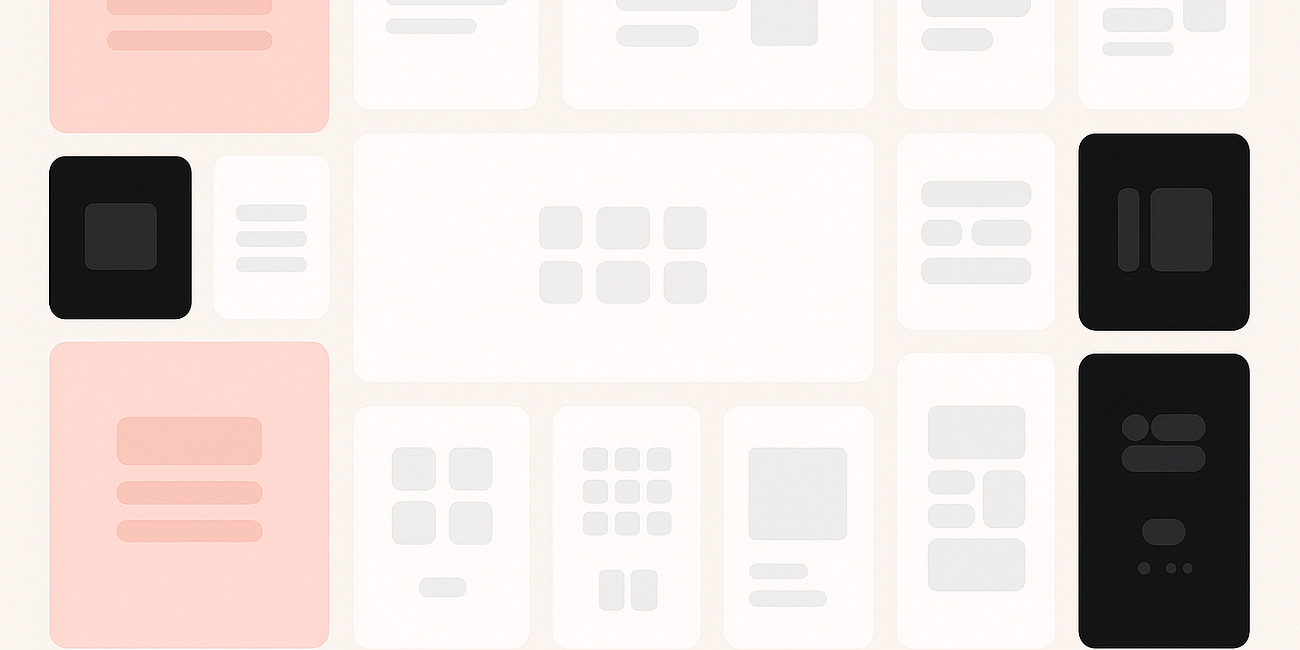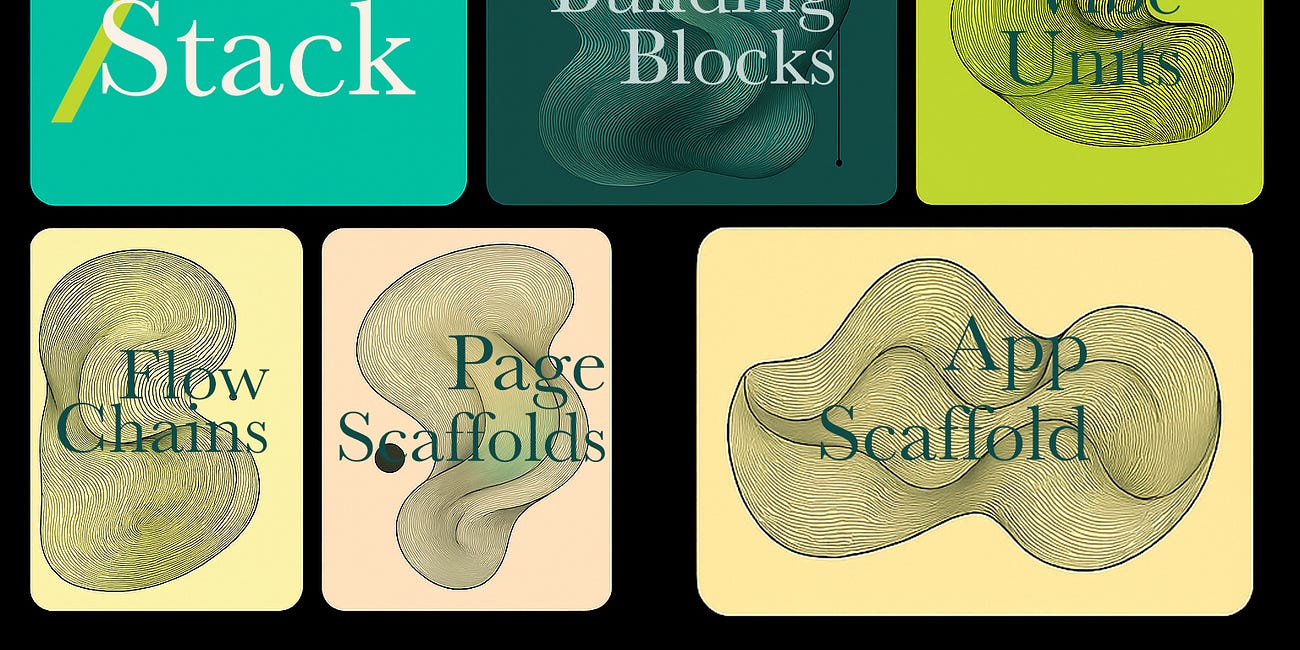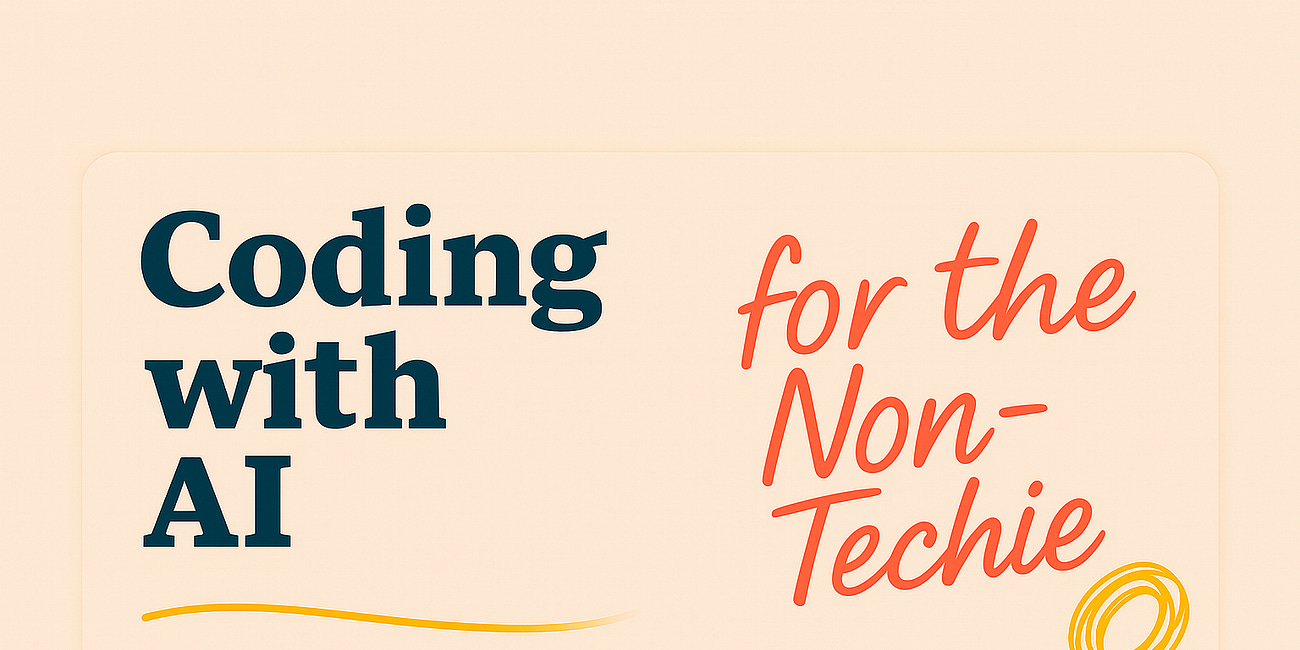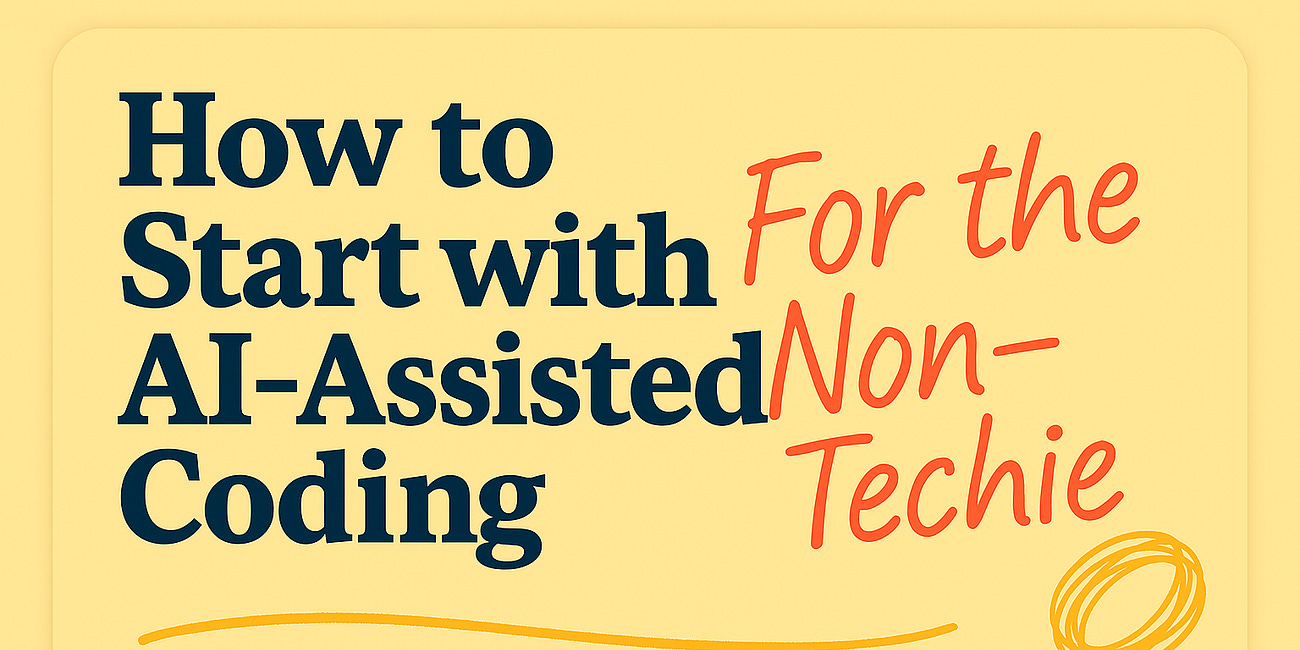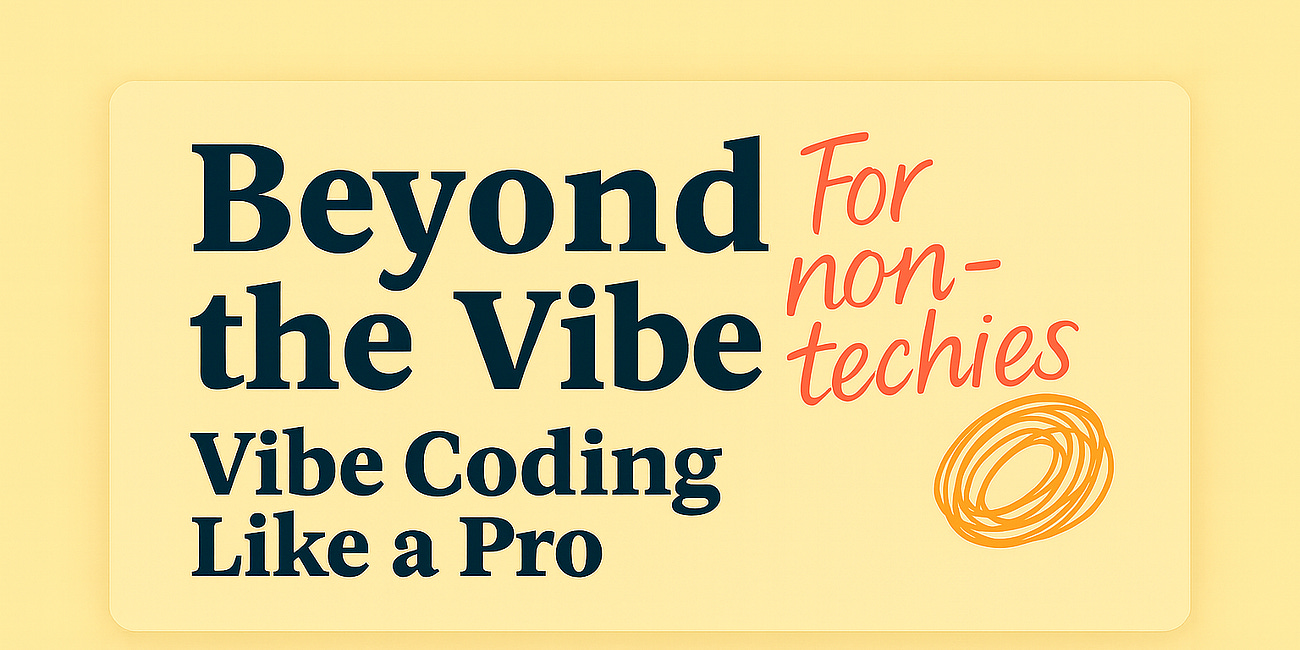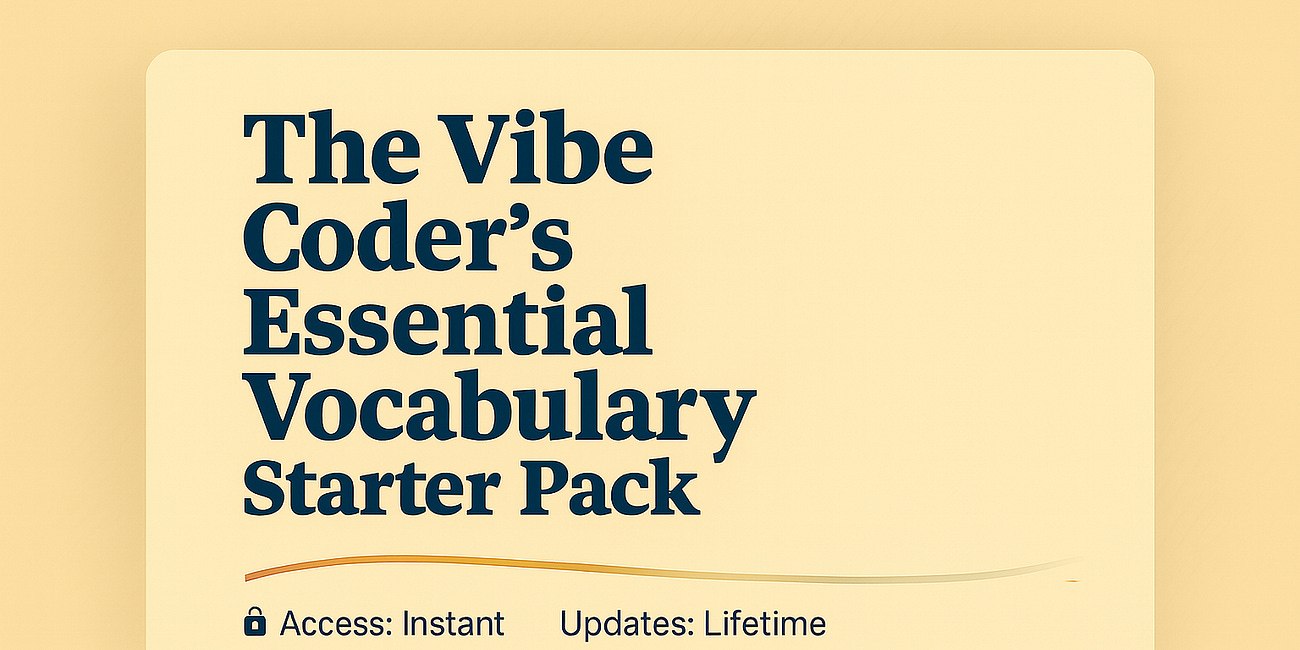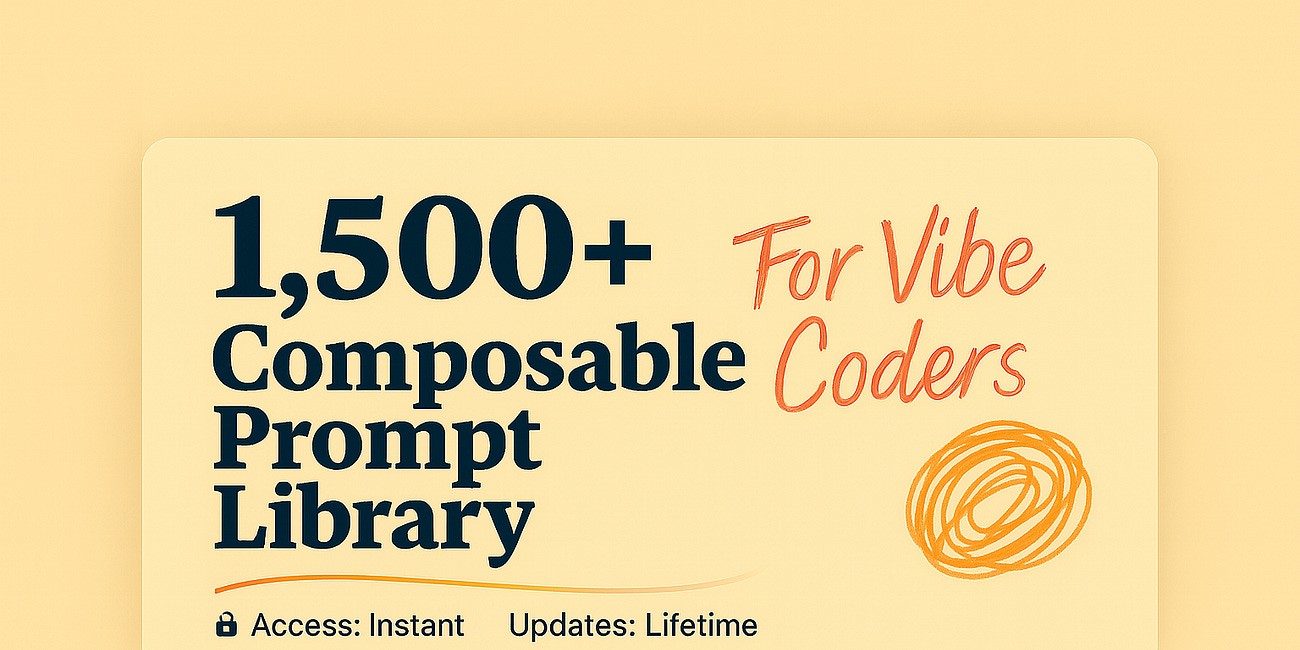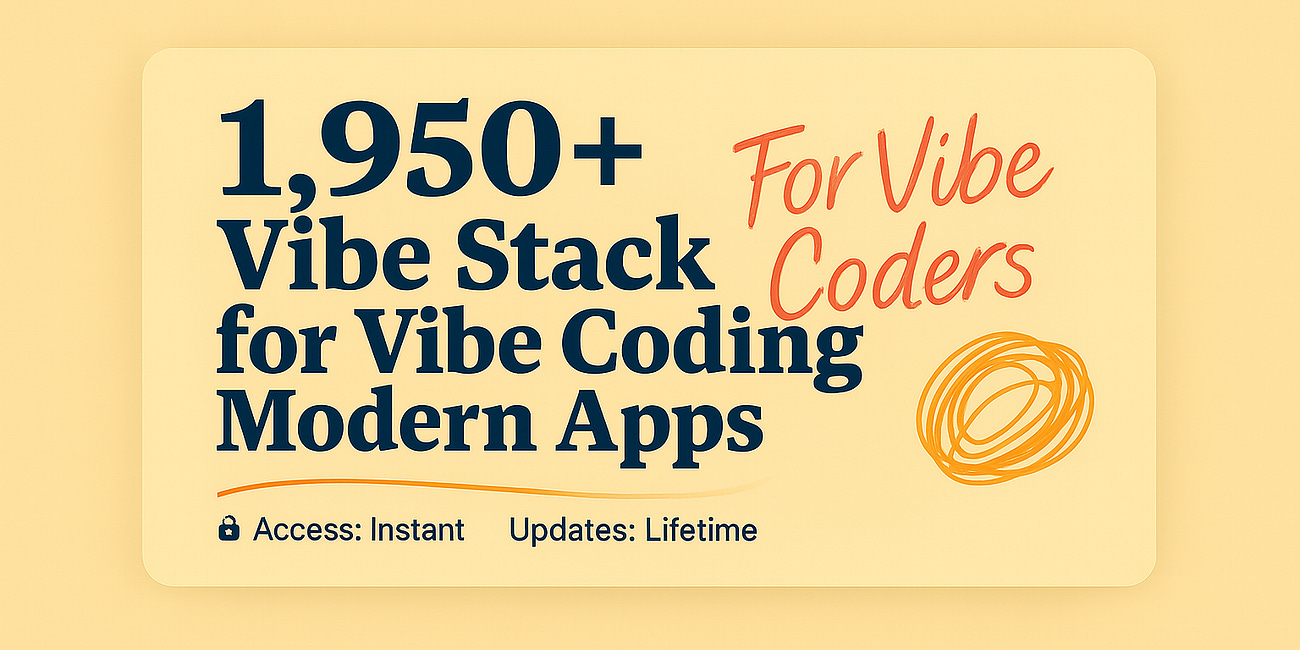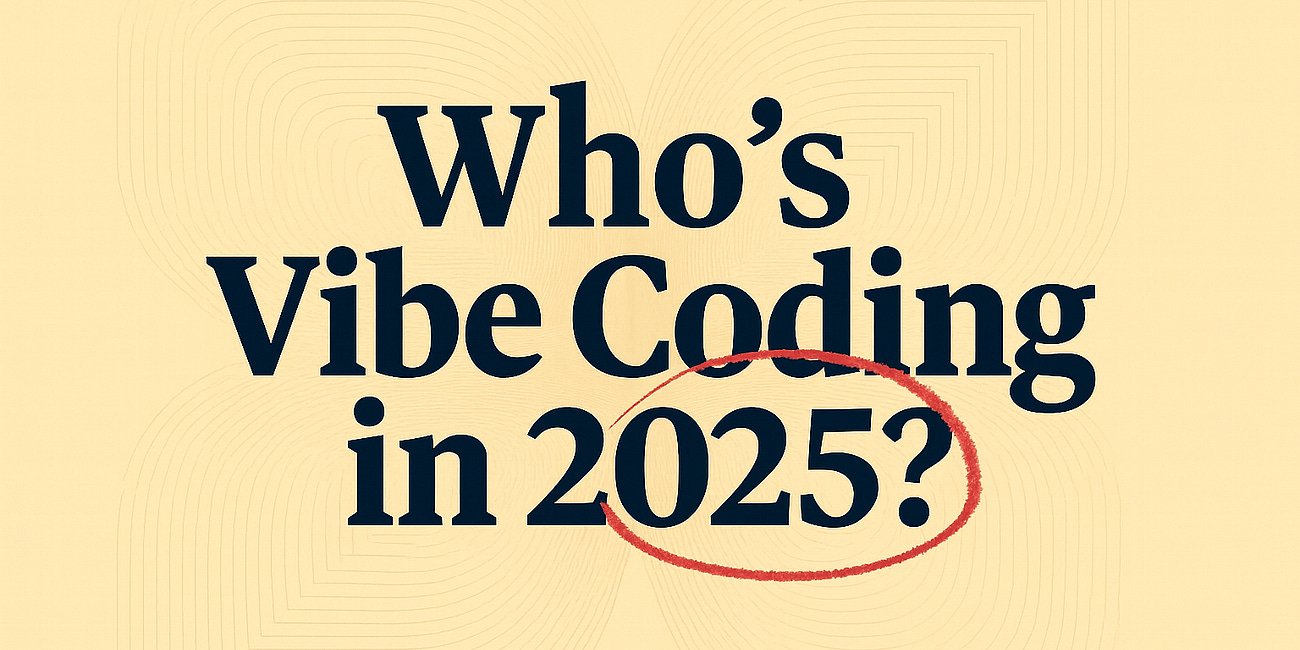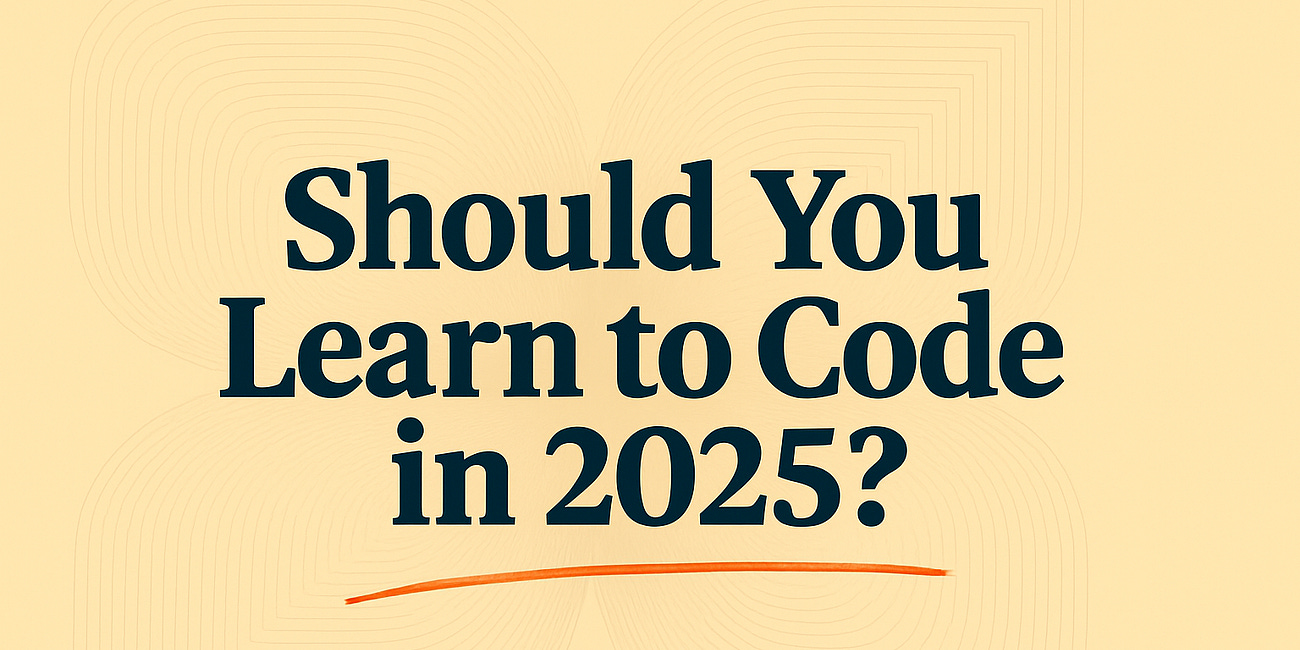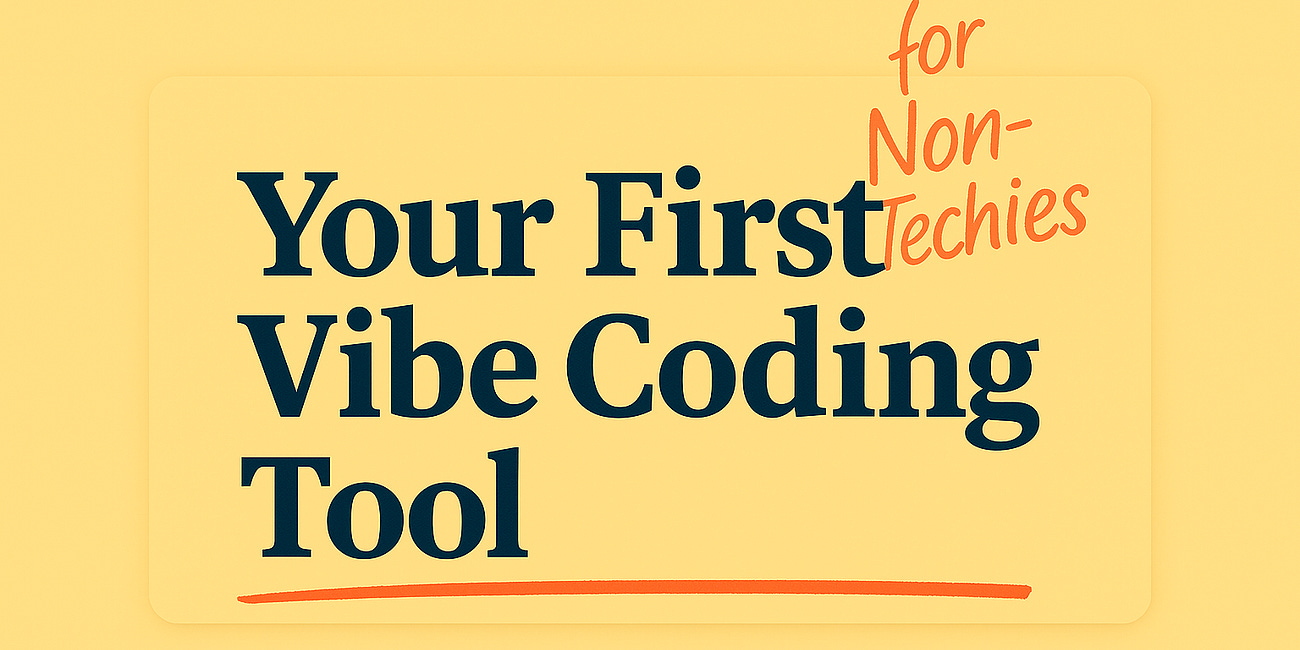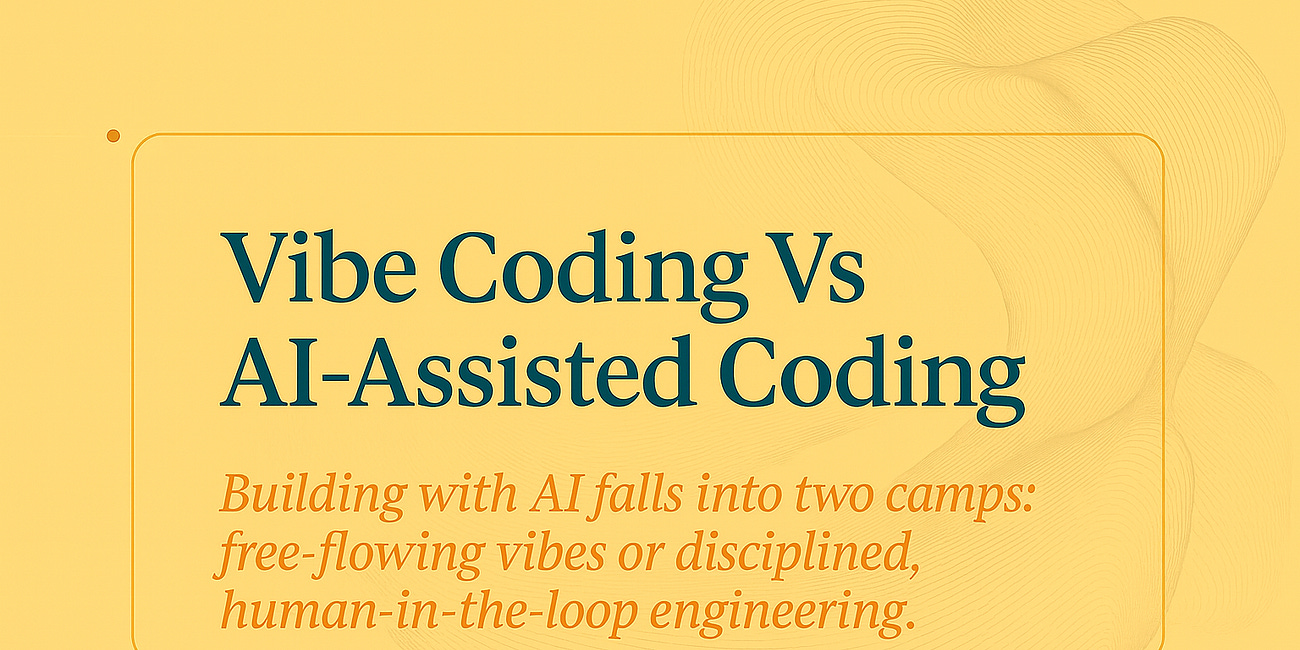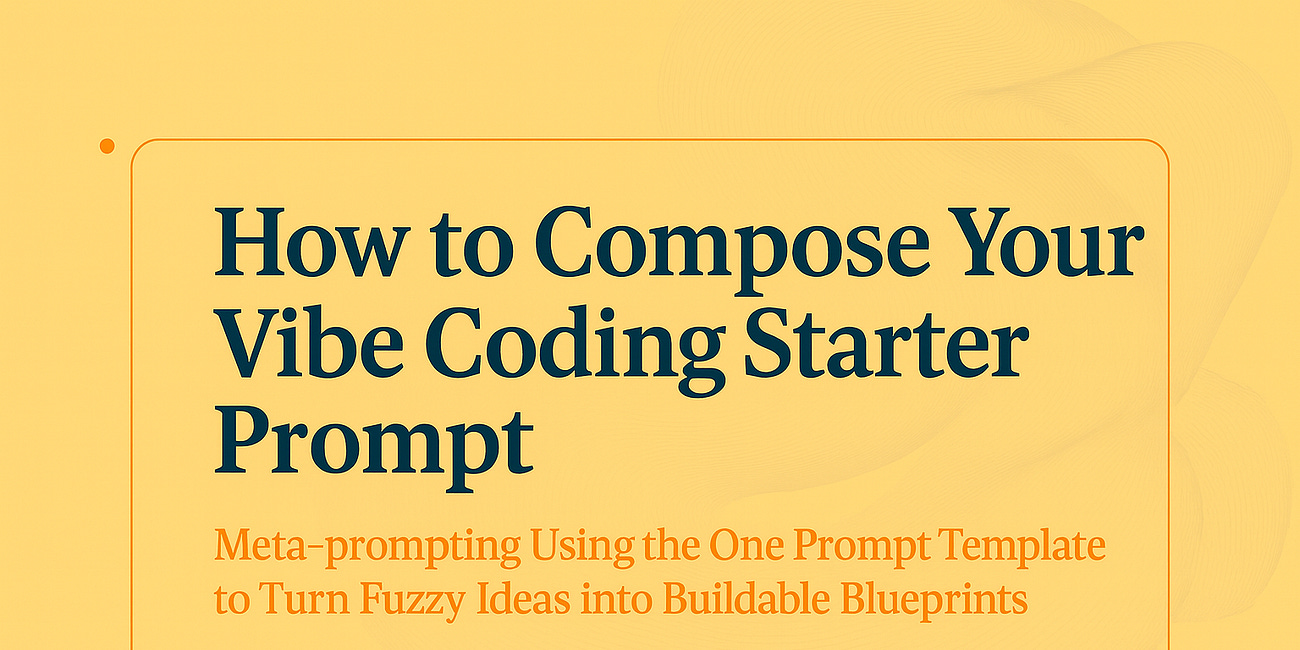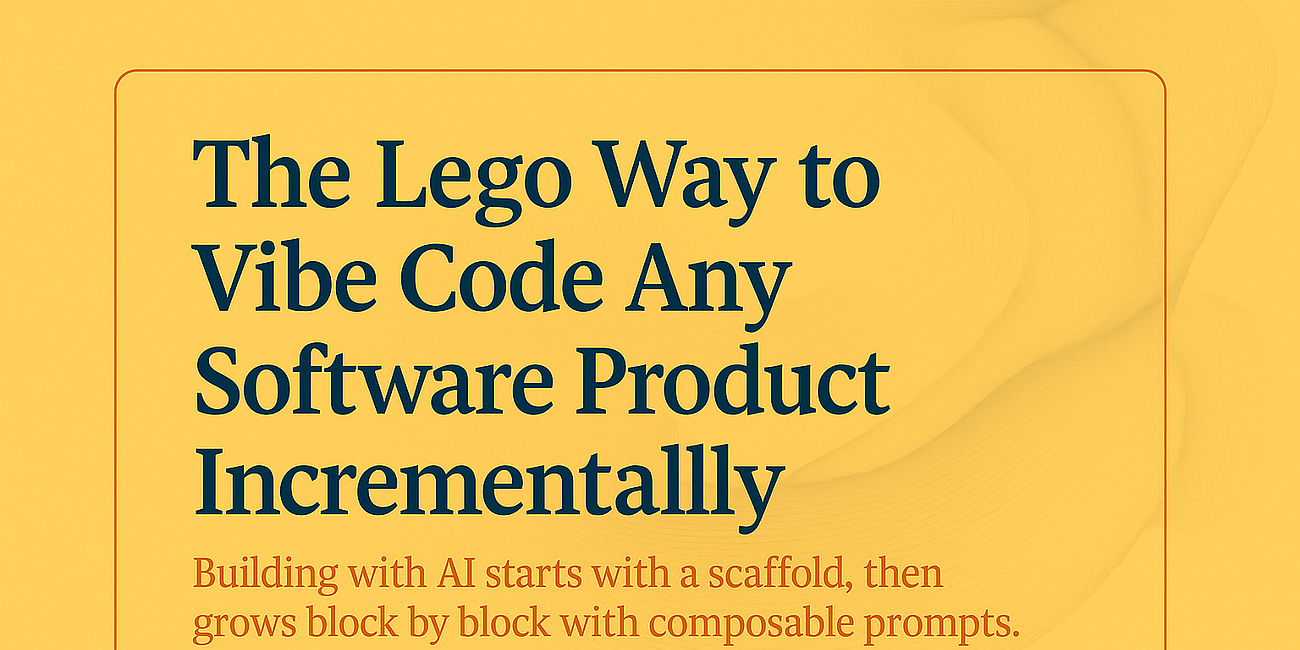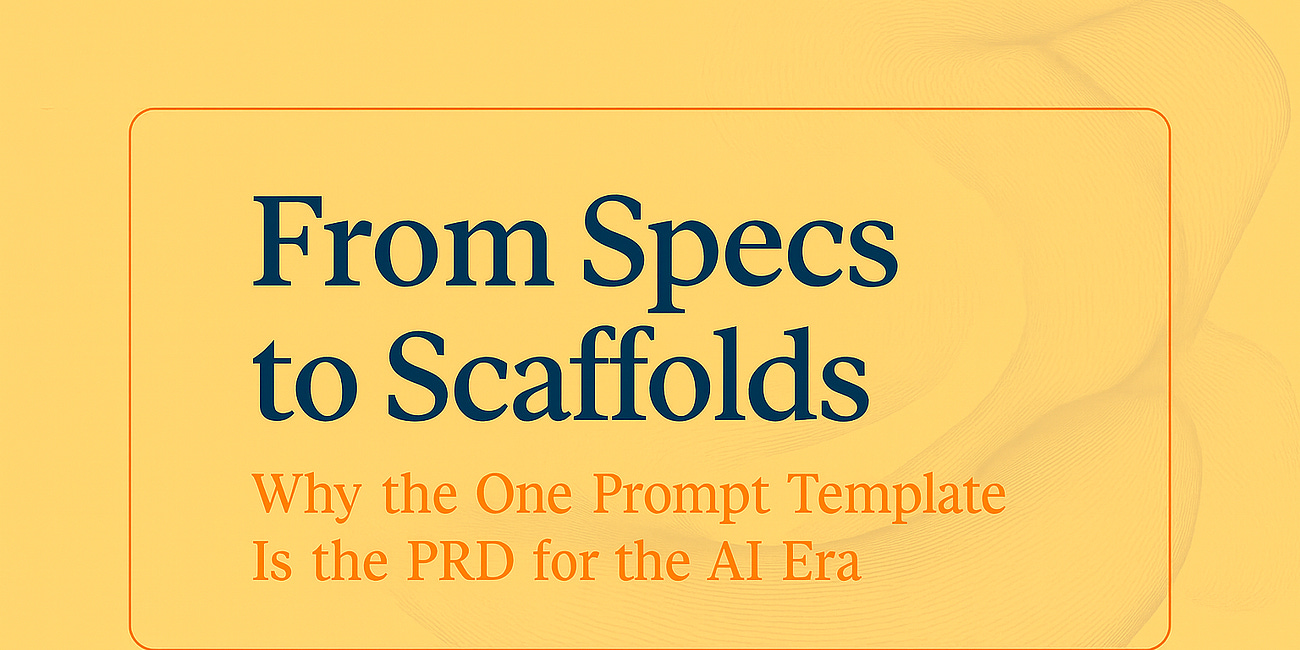The Vibe Coding Canon for Non-Techie Builders (March–September 2025)
Six months of Vibe Coding: a canon for non-techie builders, beyond the tool-of-the-week bubble to the mental model that lasts.
I’ve spent over 15 years building digital solutions, and the last five as a consultant helping others shape theirs.
But when I stepped into the world of building with AI a year and a half ago — before it was called Vibe Coding or AI-assisted coding (AI-pair programmer was the branding at the time, if I remember correctly) — I had to start again, not with code, but with questions.
At first, I was trying to understand how it worked underneath: after years of writing code and specs for others to implement business logics, here was a way of describing ideas directly and watching software appear.
Was it just glorified auto-completion? An IDE on steroids?
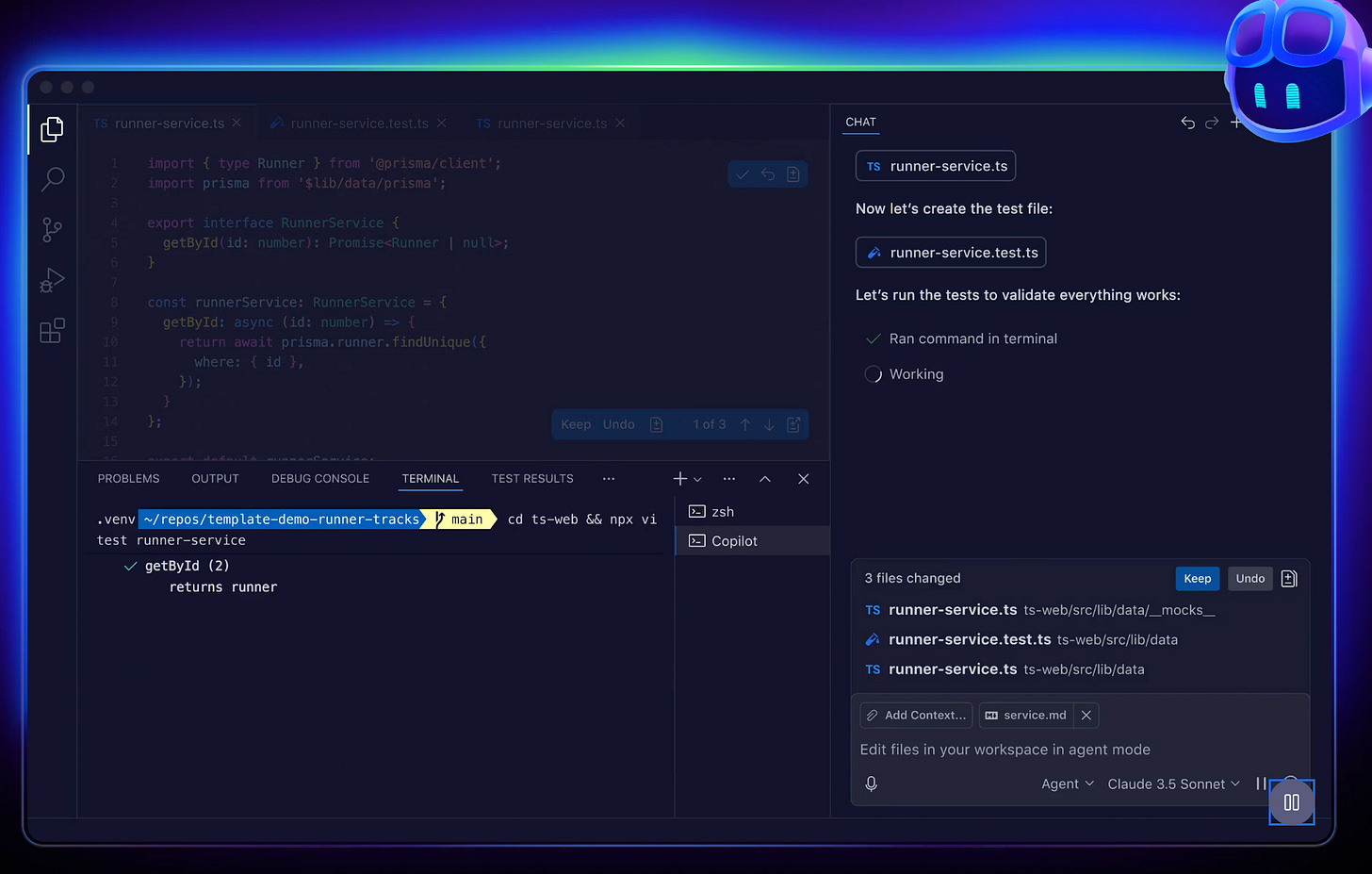
Or was it, as the people behind some of the companies developing the technology for building with AI claimed, the “great equalizer” that could expand the pool of builders from thirty million to a billion?
The excitement of early prototypes quickly gave way to a harder truth: without structure, AI outputs were unreliable. That pushed me toward searching for a framework — something that could give me agency over what AI generated.
That search led me to build a system any newcomer could use:
Learn to speak Dev without learning to code.
Think in scaffolds like a developer.
Carry the right mental models across tools and platforms.
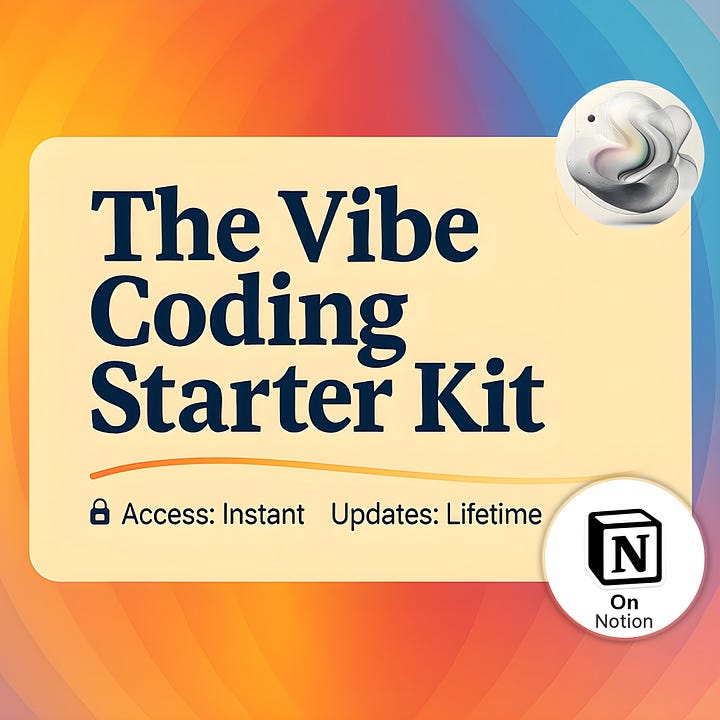
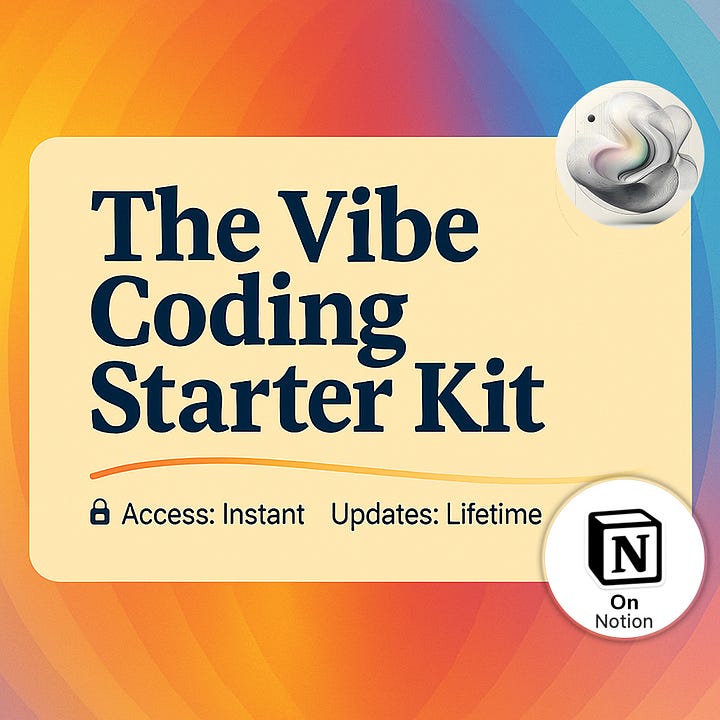
From there, I developed a scaffolding prompt template — the One Prompt Template — that can be improved incrementally using composable prompts, turning chaos into something shippable.
By September, the goal was clear: if a newcomer is to build responsibly, they need more than tools.
They need a durable mental model.
Speak Dev → Think in Scaffolds → Choose the Right Tools → Build.
What emerged from these posts isn’t a curated list of shiny tools and platforms of the month; you have the Vibe Coding/AI influencers on TikTok and YouTube for that.
It’s a framework: from learning modern software development vocabularies to scaffolding modern software to iterating with composable prompts, enabling non-techies to build with agency.
This archive is my record of that search — from curiosity to clarity, from noise to structure, from decoding what it means to be Vibe Coding (especially now that its original intent is escaping).
To make it easier to follow, I’ve organised all the Substack posts I’ve written since March into this one place. (Now that I am thinking about it as I write this, I will keep updating it with new posts I publish each week.) Together, they trace the journey: from clearly defining what it means to be Vibe Coding, to grappling with hype that seems to fuel itself through weekly new releases in AI, to scaffolding real applications, and finally to the mental models that endure.
Here is the curated list of everything I’ve covered about building with AI. After all, my Substack is called Vibe Coding, in case you haven’t noticed :)
March 2025 (My humble beginning)
Welcome to Vibe Coding
Create software using natural language. Describe it, prompt it, release it.
This initial post opened the doors: welcoming readers into the experiment of building software through natural language rather than code. It set the tone for what Substack subscribers could expect — practical resources like the Vibe Coding Starter Kit and the Prompt Kit, designed to help non-techies get started. More than just an introduction, it asserted that AI would transform not only how we build but also who has the chance to build.
👋 Welcome to Vibe Coding
Have you ever had a brilliant idea for an app or tool that could simplify your life—but felt stuck because you don’t know how to code?
The Origin Story of Vibe Coding: The Signs Were Right in Front of Us
The Shift Was Inevitable—What Happens When Vibe Coding Reaches Its Final Form?
Here, I traced the history that led to Vibe Coding, from early coding assistants to the rise of CodeGen platforms. The argument was simple: the shift from hand-written code to AI-generated software was always coming — the signs were already there. This piece framed Vibe Coding not as a gimmick but as the logical next stage of software’s evolution.
The origin story of vibe coding: The signs were right in front of us
It was inevitable—we simply refused to admit it.
April 2025
Vibe Coding: A New Approach to Building Without Writing Code
Why the next wave of software development is driven by vibes, not syntax.
This post established a definition: what Vibe Coding is, and how it differs from both traditional coding and no-code. I argued that natural language prompting isn’t just a toy but a new paradigm where code still exists — it’s just generated by AI. For newcomers, this was the clearest way to understand why Vibe Coding matters.
Vibe Coding: A New Way to Build Without Writing Code
“Vibe coding isn't a fad. This isn't going away. [Vibe coding] is actually the dominant way to code.”
How Vibe Coding Works: From Prompt to Product
You don’t code a product — you vibe it into existence.
Here, I explained the mechanics of Vibe Coding: describe the product, run prompts, refine, and watch software emerge. It was partly an orientation, partly myth-busting, demonstrating that prompts are not spells but iterative instructions. For a first-time builder, it revealed the cycle from idea to functioning product.
How Vibe Coding Works: From Prompt to Product
If you missed the full breakdown of what Vibe Coding is and why it matters, check out this primer on the paradigm shift.
How to Vibe Code Like a Builder: 15 Prompting Principles for Beginners
Proven prompting principles that turn your ideas into real, working products.
This was the first “rulebook” for non-techies. I distilled the lessons of early experiments into fifteen practical principles that prevent prompts from collapsing into chaos. It provided beginners with a toolkit of do’s and don’ts — a builder’s discipline rather than blind trial and error.
How to Vibe Code Like a Builder: 15 Prompting Principles for Beginners
When Andrej Karpathy coined the term “Vibe Coding” a few months back, some dismissed it as a meme — a clever phrase destined to fade as quickly as it trended.
Vibe Coding: How AI Is Transforming Software Development Permanently
Will developers become redundant, or will they develop into something more powerful?
This piece looked at the industry as a whole, questioning how developers themselves would change as AI took on more of the coding. I examined whether Vibe Coding signified the end of traditional development work or simply its transition into higher-order roles. It placed non-techie builders within that broader shift.
Vibe Coding: How AI Is Changing Software Development Forever
Will developers become obsolete—or evolve into something more powerful?
Vibe Code: Product Yourself and Reach 1,000+ True Fans
How Vibe Coding Enhances Naval Ravikant’s and Kevin Kelly’s Most Influential Ideas
This post combines philosophy with practice — demonstrating how Vibe Coding enables creators to transform their knowledge into software products. I connected it to Naval’s call to “productise yourself” and Kevin Kelly’s concept of “1,000 True Fans,” suggesting that AI makes these models feasible for solo entrepreneurs. It reinterprets Vibe Coding as a method to increase personal leverage, not just develop apps.
Vibe Code: Productize Yourself and Scale to 1,000+ True Fans
You won’t get rich renting out your time.
The New Age of Coding: How the Founders of Replit, Bolt, Lovable, and v0 Are Redefining the Rules of Software
Anton Osika, co-founder of Lovable, described his mission as building “the last piece of software”
Here, I engaged with the ecosystem, drawing on the voices of leading founders reshaping the way we develop. The focus was on how CodeGen platforms were positioning themselves — not just as tools, but as visions for the future of software. For readers, it was a map of who’s shaping the space and why their perspectives matter.
The New Age of Coding: How the Founders of Replit, Bolt, Lovable, and v0 Are Rewriting the Rules of Software
Anton Osika, co-founder of Lovable, described his mission as building “the last piece of software”—a tool so intuitive it might render traditional development stacks obsolete. That audacious vision captures the heart of Vibe Coding, a movement where software isn’t typed out—it’s articulated into being.
The Sober Case Against Vibe Coding — 50 Risks Vibe Coders Must Not Ignore
When code exceeds your understanding, the associated risk also increases.
Not every post was hype — this was a necessary reality check. I listed fifty risks, from security blind spots to dependency traps, that non-techies must face when allowing AI to generate code. It set the tone that building with AI is powerful, but not without consequences.
The Death of the 6-Month MVP
How AI is making product development faster, leaner, and smarter than ever
This post explained how AI shortens product timelines. What once required half a year of specifications, development cycles, and testing can now be achieved in weeks with AI scaffolds. The message was clear: speed isn’t just a bonus, it prompts a rethink of how MVPs are created and validated.
The Death of the 6-Month MVP
Not long ago, building even the simplest product meant months of effort.
Prompt > Function: Why Natural Language Is the New Stack
The End of Code-First Thinking and Why describing intent is now more powerful than writing code
Here I argued that intent — expressed in prompts — has become more powerful than raw syntax. Functions still matter, but they’re downstream of how well you can describe what you want. It reframed prompting as the new “stack” for builders who never imagined themselves writing code.
Prompt > Function: Why Natural Language Is the New Stack
For decades, the starting point of software creation was always the same: code first.
Hardcore Traditional Developers Disdain Vibe Coding. Why You Shouldn’t Worry.
A Guided Manifesto for Non-Techies Ready to Create.
This piece challenges gatekeeping. I called out the scepticism of veteran developers who dismiss Vibe Coding, while explaining why non-techies should ignore the negativity. It was written as a manifesto, a confidence boost for newcomers who feel out of place in a developer-led world.
Hardcore Traditional Developers Hate Vibe Coding. Why You Shouldn’t Care.
There’s a quiet civil war brewing in software.
May 2025
Software for One: The Quiet Revolution in How We Build, Powered by Vibe Coding
Why the Most Powerful Apps You’ll Ever Use… Might Be the Ones You Build for Yourself
This piece introduced the concept of personal software — not designed for scale, but for clarity, rhythm, and meaning in your own life. I argued that Vibe Coding enables “software for one,” a subtle revolution outside the startup playbook. It reinterpreted AI not as mass automation, but as a tool for individuality.
Software for One: The Quiet Revolution in How We Build, Powered by Vibe Coding
There’s a quiet revolution happening in software — and it doesn’t look like what we’re used to.
Can a 3,000-Year-Old Text Rewire the Way We Vibe Code?
Rick Rubin Reimagines the Tao Te Ching as a Creative Manual for AI-Assisted Coding.
Here, I turned to philosophy, drawing from Rick Rubin’s Tao-inspired approach. The post argued that ancient wisdom can shape how we prompt — with intent, presence, and clarity. It connected Vibe Coding to creativity and craft, not just productivity.
Can a 3,000-Year-Old Text Rewire the Way We Vibe Code?
It sounds wild. But maybe not as wild as you think.
June 2025
The Vibe Coding Vault
Describe it. Prompt it. Ship it. All from your private workspace to build with AI.
This post presents the Vibe Coding Builder Kit as a private workshop — a vault where you can access everything you need to build with AI, much like a traditional developer would. The Builder Kit is fully stocked with all the resources included in the Vibe Coding Starter Kit and the Vibe Coding Prompt Kit.
The Only Mental Model You Need to Vibe Code Like a Product Thinker
How the Progressive Scaffolding Framework Helps You Think in Layers, Speak in Prompts, and Build Real Apps
Here, I presented the Progressive Scaffolding Framework as the mental model that connects everything. It demonstrated how to think in layers — from UI blocks to complete app scaffolds — so prompts build into products rather than breaking apart. For non-techies, this served as the bridge into product-level thinking without coding.
The Only Mental Model You Need to Vibe Code Like a Product Thinker
Prompt First, Build Fast: A Personal Journey Through the New Era of Software Creation
The One Prompt to Vibe Code Them All
Why Prompting Is Now a Superpower — and How to Use It to Build Real Software Without Writing Code
This post introduced the One Prompt Template, the practical counterpart to the Progressive Scaffolding Framework. It showed how a single well-structured prompt could outline an entire app, from the frontend to the backend, if stacked correctly. For readers, it marked the moment Vibe Coding shifted from theory to a usable system.
July 2025
The Secret to Elegant AI-Generated Interfaces
You Don’t Need to Be a Designer — Just Speak Like One.
This post addressed design anxiety. I argued that taste in AI-generated interfaces doesn’t come from being a trained designer, but from learning to speak the language of design. It reframed prompting as a creative dialogue where clarity of description, not Figma skills, is what makes interfaces feel polished.
The Secret to Tasteful AI-Generated Interfaces
You can always tell when something’s been made by AI — the vibe’s just not there. The fonts are predictable. The colors are generic. The layout, as Meng To (creator of Aura) puts it, feels “devoid of personality.”
“Build Me X... Just Make It Work”: How to Start Building with AI Properly
Understanding Why Vague Prompts Fail and the Essential Framework for Developing Real Software with AI
This served as an anti-pattern lesson. I explained how vague, catch-all prompts lead to poor or generic results, and contrasted that with structured prompting. It acted as both a warning and a guide: lazy prompts waste time, while frameworks produce meaningful results.
"Build Me X... Just Make It Work": How Not to Start Building with AI
What makes Vibe Coding skeptics sound convincing?
The Mental Model You Must Start Building Using AI
Why Structured Prompting, Not Syntax, Is the New Base for Software Development
Here, I reaffirmed the importance of mental models, positioning structured prompting as the true foundation of AI-era software. Syntax is no longer the obstacle — clarity and scaffolding are. It provides non-techies with a guiding principle: think in structures, not in code.
The Mental Model You Need to Start Building Using AI
Everyone’s talking about building apps with AI.
Forget the Hype. Here’s the Real Way to Build Software with AI — Without Coding
When you can clearly describe what you want, AI can build it. Here is the prompt template that makes it possible.
This post cut through the noise and grounded the conversation in practice. I demonstrated how the One Prompt Template provides a repeatable approach to transitioning from an idea to working software. It was part myth-buster, part starter guide for anyone tired of hype cycles.
Forget the Hype. Here’s the Real Way to Build Software with AI—Without Coding
The Vibe Coding Hype Machine
Coding with AI is here to stay, but what does it mean for the non-techie? (Part 1)
Why the next wave of software won’t be created by coders — but by people with clarity.
This was the first half of a two-part series aimed at non-technical readers. I explained why the AI era shifts the advantage from code literacy to clarity of thought. It reframed non-techies not as outsiders, but as the new builders.
Coding with AI Is Here to Stay, but What Does It Mean for the Non-Techie? (Part 1)
AI-assisted coding didn’t sneak in quietly.
Coding with AI Is Here to Stay, but What Does It Mean for the Non-Techie? (Part 2)
From tool overwhelm to clear next steps: A plain-English guide to how non-techies can actually start building with AI
Part two moved from philosophy to guidance. I acknowledged the overwhelm of too many tools, then laid out the concrete steps a newcomer should take. Together with Part 1, it gave non-techies both the “why” and the “how” for entering this new era of building.
Coding with AI Is Here to Stay, but What Does It Mean for the Non-Techie? (Part 2)
In Part 1 of this series, we made the case that the future of software creation isn’t reserved for coders—it’s wide open to people with clarity.
August 2025
Beyond the Vibes: How to Approach Vibe Coding Like a Pro
Why the future belongs to idea people who build with agency, not just prompts
This post was about maturity. I argued that moving from “just vibes” to genuine agency is what separates amateurs from pros. It was both a challenge and an invitation: Vibe Coding isn’t just about generating code, it’s about owning the process of building.
Beyond the Vibes: How to Approach Vibe Coding Like a Pro
Sam Altman has said it clearly: we are entering the era of the idea person. As AI advances, the ability to build is no longer limited to those with years of coding experience. If you have an idea, you now have the means to bring it into the world.
When Vibe Coding: You Can’t Prompt What You Can’t Name
From Fuzzy Prompts to Ship-Ready Apps — A Vocabulary-First Guide for Non-Techies
Here, I introduced the vocabulary-first mindset: you can’t build what you can’t name. I showed how learning the language of UI, flows, and scaffolds is essential for transforming vague ideas into apps. For non-techies, this post was about literacy as the first key to unlocking potential.
When Vibe Coding You Can’t Prompt What You Can’t Name
AI can now generate entire software products from a single sentence in natural language. You’ve seen it: “Build a dashboard,” and something that vaguely resembles one appears. However, it is often not fully functional. Or it’s missing essential features. Or it just... doesn’t match what you had in mind.
The Phrasebook for Building with AI for Non-Techie Vibe Coders
1,500+ Composable Prompts to Remix, Scaffold, and Ship
This piece introduced the composable prompt library. Instead of creating prompts from scratch, I demonstrated how to utilize building blocks like a phrasebook to scaffold features. It reframed prompting as remixing patterns, rather than guessing.
The Phrasebook for Building with AI for Non-Techie Vibe Coders
Vibe Coding is transitioning from a niche experiment to a mainstream movement day by day since its inception.
Prompting isn’t building: You can’t create with AI without a blueprint.
Structured scaffolds versus wishful prompts: How the Vibe Stack helps you think like a builder.
This post drew a firm line: prompts alone don’t equate to products. I argued that scaffolds—the underlying structure of an app—are the real blueprint, and the Vibe Stack provides that foundation. It was a wake-up call for anyone treating AI like a magic trick.
From 30 Million Developers to 1 Billion Creators — The Age of Vibe Coding
AI is fuelling the massive growth of builders by bridging the gap between coders and those who never thought they could
This post expanded the perspective. I explained how AI is reducing the barriers so significantly that the pool of builders could expand from 30 million developers to a billion creators. It presented Vibe Coding not as a niche, but as a widespread movement.
From 30 Million Developers to 1 Billion Creators- The Age of Vibe Coding
The Argument Is Won: Vibe Coding Is the Future of Building
Who’s Vibe Coding in 2025?
The Equalizing Power of Vibe Coding in the Age of AI for Who Gets to Build
Here, I addressed the social aspect — who gains access and influence when AI makes software development more equitable. The piece highlighted that Vibe Coding isn’t about elite developers, but about opening opportunities for those who have been previously excluded. It rephrased the “who” as just as significant as the “how.”
Who’s Vibe Coding in 2025?
Who gets to build digital products has been disrupted forever. Large language models, the engines behind modern AI, are now capable of coding.
To Code or Not to Code: Should You Learn to Code in 2025?
AI can facilitate app development using plain language. So, does learning to code still matter, and if so, what type of coding is worth your effort?
This was a practical reflection for newcomers considering whether to learn coding at all. I argued that although AI handles much of the work, understanding certain coding fundamentals remains beneficial. It offered readers a realistic perspective: learn just enough to guide AI, not to replace it.
To Code or Not to Code: Should You Learn to Code in 2025?
“Learn to code” was as common a slogan as “eat your vegetables” a couple of years back. Parents repeated it to kids, schools built curricula around it, and bootcamps promised a ticket to a six-figure job.
September 2025
A 1-Person Billion-Dollar Company: Could This Be the Promise of AI-Assisted Coding?
The Entrepreneurial Leverage of AI as Your Co-Founder
This article examined the significant leverage AI offers to solo entrepreneurs. I questioned whether AI-assisted programming could turn the dream of building a billion-pound company by a single person into a reality, and what this implies for entrepreneurship. It positioned AI as a co-founder rather than merely a productivity tool.
Learn to Speak Dev Before Reaching for Vibe Coding Tools
The Literacy Step Most Beginners Miss When Starting to Build With AI
Here, I emphasized that vocabulary comes before tools. Too many newcomers rush into platforms without understanding the words to describe what they want AI to create. This post argued that learning to “speak dev” is the first unlock for non-techies.
Learn to Speak Dev Before Reaching for Vibe Coding Tools
Getting Started with Vibe Coding: A 4-Part Series (Non-Techies Edition)
Think Like a Dev, Think in Scaffolds
The second skill every Vibe Coder needs after learning to speak Dev
This piece builds on the literacy stage. Once you can speak Dev, the next step is learning to think in scaffolds — viewing apps as layers of UI, flows, and data. It positions scaffolding as the mindset shift that transforms prompts into functioning systems.
Think Like a Dev, Think in Scaffolds
Getting Started with Vibe Coding: A 4-Part Series (Non-Techies Edition)
Your First Vibe Coding Tool: How to Pick the Right Platform/Tool Without Getting Lost
A beginner’s guide to the 5 categories of Vibe Coding apps — and how to find where to begin
This post helped newcomers navigate the overload of AI coding/ Vibe Coding tool/platform options. I outlined the five categories of Vibe Coding platforms and showed how to match each to your goals. It was a practical guide for making smarter choices instead of following hype.
Your First Vibe Coding Tool: How to Pick the Right Platform/Tool Without Getting Lost
Getting Started with Vibe Coding: A 4-Part Series (Non-Techies Edition)
How to Actually Start Vibe Coding (The Responsible Way)
Central code storage, trust layers, professional UIs, secure APIs, and delayed add-ons
This section provided specific details. I broke down the components of a responsible stack — central code storage, trust layers, professional-level UIs, secure APIs, and cautious approaches to add-ons. It offered newcomers a blueprint to move from curiosity to disciplined practice.
How to Actually Start Vibe Coding (The Responsible Way)
Getting Started with Vibe Coding: A 4-Part Series (Non-Techies Edition)
10 Practical Moves for Vibe Coding Without Burning Out
The practical foundation beginners overlook when chasing the latest tool
This post focused on sustainability.
I outlined ten tangible habits and practices that help builders avoid fatigue while experimenting with fast-moving AI tools. It was a reminder that pacing and process are just as important as prototypes.
10 Practical Moves for Vibe Coding Without Burning Out
It is easy to get carried away by the shiny new AI-infused web-based and mobile app building tools that promise the future of product development without the need to write “a single line of code.”
Vibe Coding vs. AI-Assisted Coding: The Only Two Categories That Matter
Forget the buzzwords. Building with AI falls into two categories.
This piece clearly distinguishes between Vibe Coding and AI-assisted coding. I cut through marketing talk to show that all approaches fit into one of two groups: quick, free-flowing prototyping or structured, human-in-the-loop engineering. It offers readers a clear map of the field, free from marketing noise.
Vibe Coding vs. AI-Assisted Coding: The Only Two Categories That Matter
The working definition of “building with AI,” which involves using natural language to generate working software, is already slipping. It is losing its original intent on one side and becoming diluted on the other. What began as an exciting shift is now drowning in hype, hostility (trust me, you will feel that on Reddit), and half-baked labels.
How to Compose Your Vibe Coding Starter Prompt
Meta-prompting Using the One Prompt Template to Convert Fuzzy Ideas into Constructible Blueprints
Here, I revisited the fundamentals of prompting. I demonstrated how to utilise the One Prompt Template as a meta-prompting foundation to turn vague ideas into organized app blueprints. For newcomers, it was the hands-on guide to getting started.
How to Compose Your Vibe Coding Starter Prompt
You can open any AI coding tool or CodeGen platform today and ask it for something simple—or outrageous.
The Lego Way to Vibe Code Any Software Product Incrementally
AI won’t build your app all at once. We are not there yet. You will find half-wired features scattered throughout. You can only reach the final result through gradual scaffolding using composable prompts in an iterative manner.
This final post highlighted the incremental nature of Vibe Coding. I compared it to Lego: you don’t unpack a finished castle, but snap pieces together until a structure appears. It serves as a practical reminder that AI-assisted building is iterative — scaffold first, expand later.
The Lego Way to Vibe Code Any Software Product Incrementally
Even with today’s 1M-token models, you can’t create a fully integrated app in a single step. AI will generate scaffolds with partly functional features, but modifying one part often causes the rest to fall apart.
From Specs to Scaffolds: Why the One Prompt Template Is the PRD for the AI Age
PRDs provided teams with alignment. Spec-driven documents offer AI context. The One Prompt Template gives non-techies a way to build software without feeling overwhelmed.
This post reinterpreted the One Prompt Template as the non-techie’s equivalent of a PRD. I argued that, just as PRDs once aligned teams, structured prompts now align humans and AI, providing context without overwhelming them with technical detail. It positioned the One Prompt Template as both a mental model and a practical bridge to spec-driven development.
From Specs to Scaffolds: Why the One Prompt Template Is the PRD for the AI Era
Why Building with AI Feels Broken Without Structure
I began researching AI-assisted coding with nothing but questions. That search quickly became a decision: to share my own experience as I learned, so others entering this space wouldn’t have to start alone.
This archive is my record of seeking clarity in a shifting landscape of building with AI—and an invitation for you to walk the path with me, whether through Vibe Coding or AI-assisted coding.
Over the past few months, I’ve tried to help newcomers make the transition: first by learning to speak Dev, then by thinking in scaffolds, and finally by identifying the mental model that endures across tools and platforms.
Now a new milestone is approaching.
I want to begin the next journey by exploring AI-assisted coding tools and CodeGen platforms one at a time — and I invite you to join me as the journey unfolds.
👇 Subscribe now. Your ideas deserve to come alive.
You’re not just learning — you’re building. This is your builder’s playground. Let’s go beyond vibes and start Vibe Coding with intent.
Vibe Coding is here to stay.
The debate has been settled.
Now, the question is: are you ready to bring your ideas to life?



